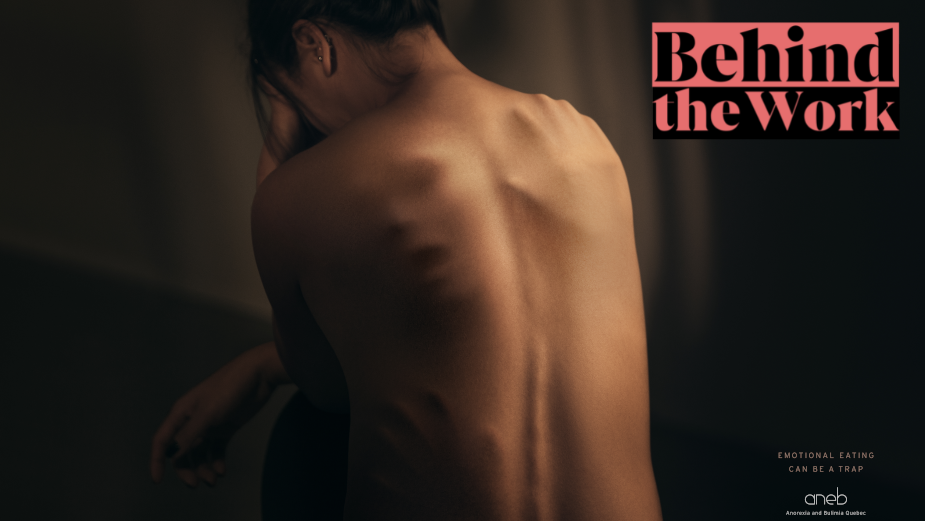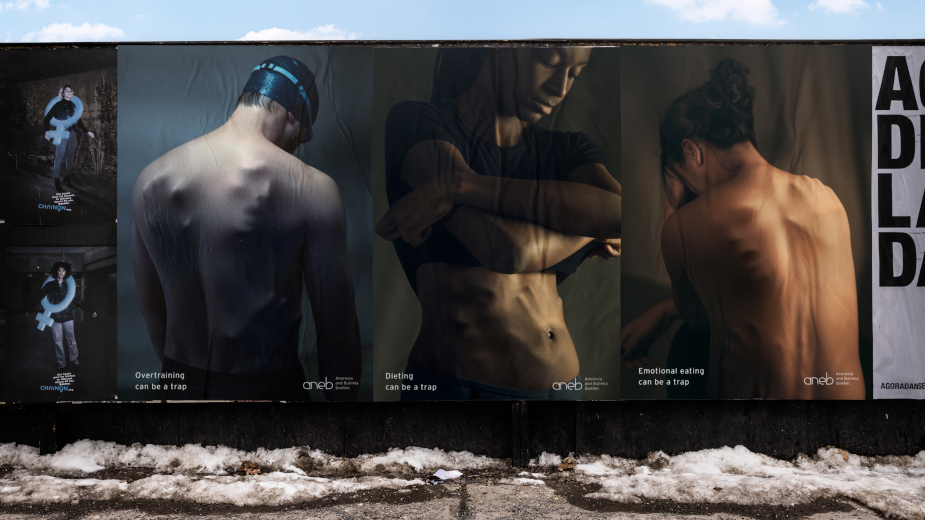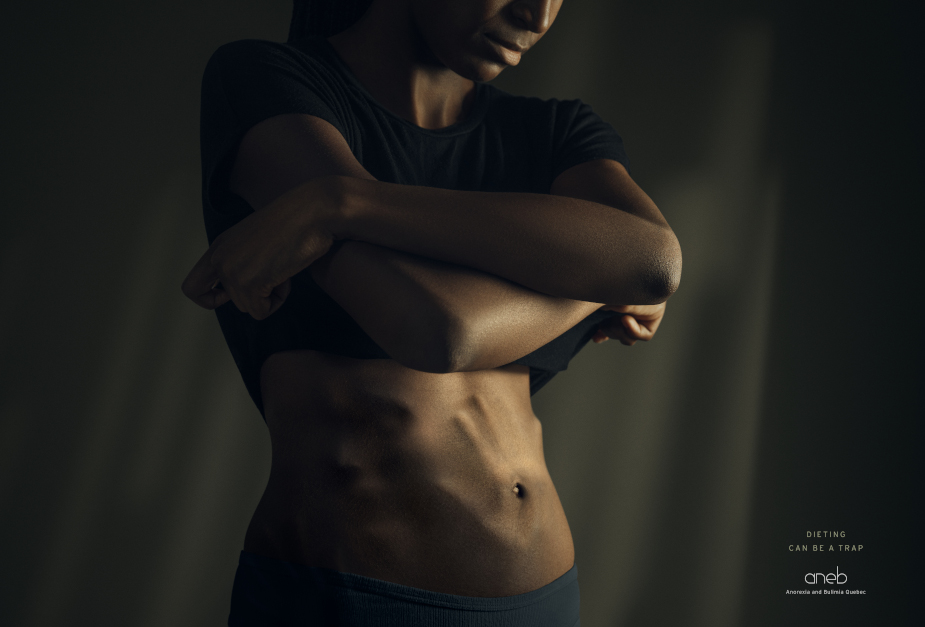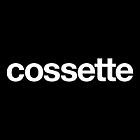
Why Anorexia and Bulimia Québec Explored the Feeling of Being Trapped in One’s Own Body

According to the Canadian Mental Health Association Kelowna, an estimated one million Canadians would meet the diagnostic criteria for an eating disorder (ED). Worse, of any mental illness, EDs pose the highest death rate, with one in 10 people ultimately succumbing to their disorder.
It’s a grim prospect, made only worse by the fact that it can happen to anybody. Regardless of race, gender or body type, eating disorders can affect anyone, and can be an oppressive burden to carry alone.
It’s for this reason that organisations like Anorexia and Bulimia Québec (ANEB) exist. Seeking to offer support and resources for those struggling, part of its goal is to raise public awareness of the various eating disorders that exist, in order to draw attention, spark conversation, and let impacted people know that, in fact, they do not have to face the fight alone.
Most recently, this came through the organisation’s continued partnership with creative agency Cossette, which saw the two release a new online, print and OOH campaign throughout the Canadian city of Montreal. Exploring the idea of being trapped in one’s own body by depicting various eating disorders as faces trapped beneath the skin, the work illustrates the pain and isolation that people struggling with EDs face. Moreover, each and every piece features a ‘can be a trap’ tagline, reminding viewers that even normalised behaviours like dieting or over-exercising can serve as a trigger for EDs.
LBB’s Josh Neufeldt sat down with Cossette Quebec City copywriter Nadine El-Whidi, art director Nicolas Baillargeon and ANEB Québec executive director Josée Champagne, to discuss how this sensitive and striking work came to be.

LBB> What was the brief for this campaign, and what immediate ideas came to mind?
Josée> Eating disorders (EDs) do not discriminate, and can make anyone feel trapped. EDs can affect anyone, regardless of sexual orientation, ability, ethnic background, gender, or age. That’s why it’s essential to break taboos in all communities, so everyone can get the necessary help and feel welcomed and heard by professionals. For these reasons, we have to continue our efforts to raise awareness, so we can dismantle the prejudices that persist about EDs.
ANEB and Cossette have been working together for many years. They are a very valued partner for our organisation, and are extremely sensitive to the issues surrounding eating disorders.
Nadine> Our client noticed that the people reaching out to ANEB mostly fit the same profile: thin, young, white girls and women. In reality, anyone can suffer from an eating disorder, and there are more than just anorexia and bulimia, which have been discussed a lot in the past two decades. Therefore, the goal of this campaign was to showcase a diverse range of people affected by all sorts of eating disorders.
LBB> Please tell us more about ANEB! Are eating disorders a particularly prevalent issue in Quebec, compared to the rest of Canada?
Josée> ANEB is a non-profit organisation that guarantees free, immediate, and specialised help to people with an eating disorder, and to their loved ones. ANEB has offered specialised services for 35 years, and maintains its presence in various places in the community to raise awareness of these mental health issues. Through a variety of educational services and new partnerships, the organisation helps to prevent and lessen the consequences of eating disorders.
Eating disorders are a very prevalent issue across Canada - including Quebec - which is why we collaborate with numerous partners across the country.
LBB> The idea of being trapped in one’s own body is very poignant. Were there other ideas under consideration? And what made this the approach you wanted to go with?
Nadine> Yes, but in that case, we found ourselves focusing on one particular and lesser-known eating disorder. With this idea - being trapped in one’s own body - we could showcase a variety of eating disorders.
Josée> The notion of being trapped or being in a prison is a narrative that’s often shared by people who have an eating disorder. This theme showcases how debilitating the illness can become.
LBB> Addressing eating disorders in Quebec is a sensitive topic. As such, what was the research process like, what were the key takeaways, and how did they factor into the creative process?
Nicolas> During our research process, we noticed two things. First, people who don’t suffer from eating disorders have a misconception that it’s just an obsession with weight or looks. And second, we read lots and lots of testimonials mentioning major distress. People’s pain was bigger than food or looks or weight. It’s a real mental illness that has extreme consequences on their well-being, in every aspect of their lives. Moreover, we are all at risk. Normal behaviours, such as exercising, could lead to an eating disorder if you go through a rough patch in life.
Josée> Indeed, addressing eating disorders is a sensitive topic. This is why it’s important to have campaigns that avoid perpetuating false stereotypes around eating disorders, including the notion that eating disorders affect only young adolescent girls. These stereotypes can prevent people from seeking the help that they need.
Another key factor to consider is that eating disorders are more than just symptoms. They are important mental health issues that affect people’s personal, social, emotional, psychological spheres.

LBB> Specifically, it’s noted that isolation is one of the main consequences of eating disorders. Why is this?
Josée> This is a complex question, given that every situation is unique, but indeed, eating disorders and isolation go hand in hand. We tend to see that people isolate themselves because they feel shame about their illness. Many people with eating disorders tend to want to avoid conflicts and triggering events or comments, especially when there are occasions where food is present. I would also add that as the eating disorder progresses in someone’s life, it tends to push away everyone who wants to help. Also, although EDs are a maladaptive way to cope with life’s struggles, they’re nevertheless a coping mechanism that individuals have found, and it’s difficult to change this in an individual - without proper help.
LBB> Let’s talk about the OOH designs. How did you select which eating disorders you wanted to address, and what was the writing process like for the ‘can be a trap’ lines?
Nadine> We selected disorders that weren’t as discussed in society as anorexia, since this is the most well-known eating disorder right now. We also selected eating disorders that can be triggered by seemingly normal or encouraged behaviours such as dieting, training or comfort eating.
We tried a lot of different options during the writing process, but we felt like ‘trap’ was the best option. These behaviours start innocently enough, so they can be a trap that leads to real trouble, which then creates this feeling where you’re trapped within your own body and can’t escape it without proper help - which ANEB can provide.
LBB> In the same vein, what was the photography process like? Who did you work with on this, and who did you cast for the photos?
Nadine> We worked with Studio LeQuartier for photography and editing, since we needed retouching experts to achieve the polished look of the faces trapped inside the bodies that we ultimately got.
For the casting, we worked mostly with people we knew who were willing to participate in the campaign because they felt compelled by its mission and its message. It was important that we showed more diverse profiles than the usual super thin, super young blonde girl, so we kept that in mind throughout.
LBB> How did you achieve the effect of faces trapped inside bodies? And as a whole, what was the editing process like?
Nicolas> We photographed the same models using stretch fabric to create the silhouette effect, and then integrated the image into a photo montage.
LBB> Which piece in the OOH collection stands out the most for you?
Nadine> The bigorexia print, for sure. It’s rare when discussing eating disorders that we feature male sufferers, for one, or athletes - people who are revered for being ultra healthy. However, eating disorders thrive in this environment because of the obsession with health, strength and performance - key triggers that can be detrimental to both physical and mental health.

LBB> What challenges have you faced during this project? How did you overcome them?
Nadine> Eating disorders have been massively featured in ads for the past two decades, so finding an idea that was fresh and could suit many of these disorders was an enjoyable challenge.
Josée> Given the complexities of eating disorders, one of our biggest challenges was figuring out how to reflect the wide range of eating disorders in an advertising campaign. As mentioned previously, eating disorders do not discriminate. They can affect anyone, regardless of all other factors. One of the ways to overcome that is to not fall into the stereotypes around EDs, and to dismantle the prejudices that persist.
LBB> What has the initial response been like? Have people reacted well to this campaign?
Nadine> I’ve seen the campaign a lot on social media - shared by people in the industry from around the world. But, most importantly to me, I’ve also seen it shared by people I’ve met at different stages of my life, and who did so because they were genuinely touched by the prints and wanted to spread awareness within their own social circles.
Josée> The response to this campaign has been extremely positive. In fact, it was one of the most shared campaigns on our social media!
LBB> What made now the right time for this campaign? And how does it fit into your platform for 2023?
Josée> The timing was perfect. This campaign was developed for National Eating Disorder Awareness Week, which takes place from February 1st to 7th every year. During this time, there’s a heightened interest in eating disorders across Canada.
Also, we and our partners have demonstrated more efforts over the years to create services that are adapted to specific groups within our community with EDs, such as the BIPOC and LGBTQ2S+ communities.
LBB> Working on a project that addresses eating disorders must have been a powerful experience. What did the chance to be involved in this project mean to you?
Nadine> Honestly, for me, it’s been a little bit triggering. Having been raised in a competitive sports environment, I’ve seen a lot of my friends suffer from eating disorders, and I’ve struggled with disordered eating myself.
However, it was also so rewarding to work on a subject that truly matters to me. Maybe, with a little more education and understanding, we can encourage people to recognise their problematic behaviours and, slowly but surely, change attitudes towards diet culture, eating disorders, mental health, etc.
LBB> Is there anything you’d like to tell Canadians about how they can support the work you’re doing?
Josée> Given that we are a non-profit organisation, donations are always appreciated. People are invited to visit our website for more information.
LBB> Do you have any advice for people dealing with eating disorders/people who know someone facing these struggles?
Josée> My advice would be to reach out to existing resources and to get as much information as possible. Eating disorders are complex issues and the more one is informed, the more one can understand them. It’s important to remember that eating disorders are not a choice, and that recovery takes time and isn’t linear. Also, you can help loved ones and friends who you may feel are struggling with an ED by offering them comfort and moral support.











